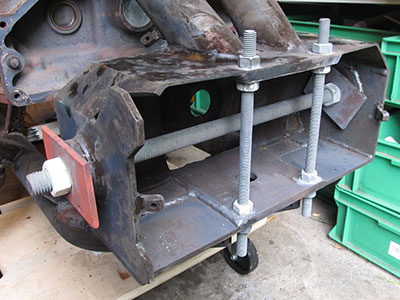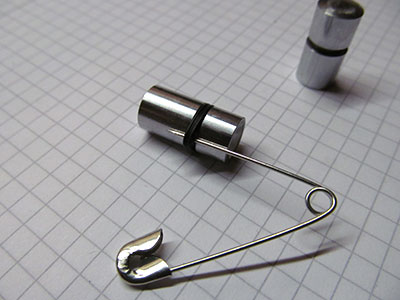
It's been a while, a lot has happend. Time for V8 update #6!
Starting with Klaus Sarembe making the final construction welds on the frame.

'Terminator VI: The Final Construction'.



It turned out there was a lot of tension in the frame: only with force the front and the rear half could be bolted together, no good. So I decided (although not much of a choice) to heat the whole frame in an oven to get the tension out.
First of all I scored myself an old 350 engine ...


... and bolted the crankshaft to my garage; always wanted a V8 crankshaft above the entry.

I bolted the frame to the engine and took it to Smit Gloeidienst. For very little money and within a week (thanks guys!) they heated it up with 30°C per hour to about 570°C. When this temperature was reached the oven cooled down with 50°C per hour, to 100°C. This procedure is called 'annealing treatment'.

Of course the tension in the steel has to go somewhere. I 'protected' the parts that shouldn't be affected with massive studs.

After the heat treatment I cut the studs in half; they didn't move a bit which proved the tension was gone.

I continued with the casing for the clutch, which was a very difficult and time consuming job. Had to put a lot of strips at the inside to get the armour plates fixed.

Looks a bit Mad Max, doesn't it?

Hans and I puzzled for days to construct one-off strips. If you do this right ... no one will ever see them again. Bummer.





We had to fill in a lot of papers.
RDW stage one was a success. The second stage, at the testing center in Lelystad, will be far more stressful: then the complete bike will be tested on a lot of criteria.



Which was not the case for the inside of the fuel tank. A few years ago I treated it with Tank Cure, a 2K substance to seal the tank. The additives to petrol have changed dramatically in recent years, and Tank Cure was no match for these contaminants; I had to remove it all ...

... which was a hell of a job. But what isn't in this project? ;)







... and closed.

Some milling ...




The bike's paint job is a two stage job as well: one before and one after Lelystad. Kustombart dared to take up the challenge.


Special treatment for the bottom of the tank too. Yes, the same filler ...



The rest of the painted parts are black. Of course.
On the left you see a part of the tank, and Tjeerd's dog.

Gold and black. That reminds me of the good ol' Formula One days. Ayrton Senna in his JPS Lotus, almost thirty years ago. Yes, that was before I even started this project. Unbelievable eh?

The steering head tube was not perfectly round anymore, not perfect enough for fitting the bearings anyway. Klaus and me constructed a special tool to scratch out the tube.

Because just hammering the bearings in: no way. It took a whole day but in the end they fitted like a glove.

I overhauled the hydraulic clutch unit as well, and replaced the small pistons.

The new ones have the grooves and the seals at a lower position so the pistons can make a longer way.

Heat. Did I tell you about heat already? I hate heat.
The pre-turbo water-methanol injection system (see previous V8 update) was not sufficient: the droplets were just too big, not atomized enough, to get an efficient cooling of the intake air. So I started designing an alternative new system with an electric high pressure pump.

But there was no way I could position this big pump on my bike. It would just look bulky.

The third (and hopefully final...) system I designed is as follows:
1: I'll sacrifice one of my NOS bottles for the water-methanol system by filling it with 10 bar of air or nitrogen.
2 and 3: I'll lead the 10 bar to a pressure regulator with an output op 5.4 bar. Why 5.4 bar? 3.4 bar to atomize the water-methanol pushing against max. 2 bar turbo pressure.
4: The 5.4 bar will put pressure on the water-methanol in my swing arm.
5 and 6: Two hoses at the bottom of the swing arm lead the fluid to the solenoids which are controlled by the motor management system.
7. At full throttle the water-methanol will spray into the intake manifold.
It is a nice theory, and I'm looking forward experimenting with it. But right now it's not my main concern: at lower revs, the intake temperature isn't a real issue because the engine has enough power, even without extra cooled intake air.





The end of March Peter and Niels worked on the wiring together.


April 13th 2014: the first engine start since one and a half year, since October 5th 2012. After a minor problem with the wiring the engine ran instantly, and sounded like it had never been shut down.

"Is that all you've done?"
Well no. Hell no! But the more the bike reaches its final looks, the less I can use any pictures without revealing it. To give an impression: new cylinder head covers, installed new master brake and master clutch cylinders, added a overflow tank for the cooling system, replaced the clutch release bearing and the clutch pilot bushing, made new heat shields for the exhaust, improved the side stand, finetuned the gear drive, improved the rear braking system and the crankcase breather.
What's next? Next month a final (I hope) Dyno test, a final (I hope) street test, clearing lots of small (I hope) problems. And then: Lelystad, here we come!
To be continued ... here.